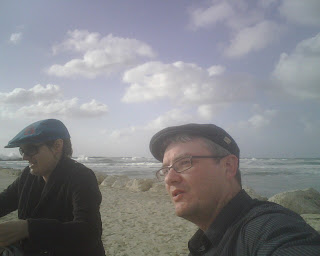I Like It!
This past
Shabbat, along with Jonathan Lewis and my wife, Katrin, I attended Shirei
Chagigah in North London at the Alyth Synagogue. Aside from being transformative
in its own right and allowing me to meet over half of my UK Reform rabbinical
colleagues, the conference seemed tailor-made to address some of the questions
that we will all wrestle with over the next weeks, months and even years.
As we were
introduced to melodies including quite a few unfamiliar to me, the natural
questions of musical taste and preference in synagogue settings arose. This
moved conversation inevitably to the complexity of introducing new melodies or
musical styles into a community.
Perhaps it
is comforting to know that these issues are universal. There were more
discussions on how to teach new music and then deal with the resistance within
a congregation than any other single subject. And within our discussions on
“change” since I arrived, this is probably the element of change that is most
critical to acknowledge and unflinchingly discuss. In short, any time I use a
melody that is not part of Sinai minhag
(custom) or any time I pick up my guitar, there will be reactions and differing
emotions.
The reality
is, Judaism has acknowledged how complicated and problematic music can be with
thousands of years of extraordinary ambivalence. On the one hand, we have David
HaMelech the Psalmist dancing, singing and acting as the first musical
therapist and on the other hand the forbidding of musical instruments in the Shulchan Aruch for Shabbat worship. In
the Talmud, music is conflated with magic and mysticism-- uncontrollable forces
that are looked upon as something to be understood by only the most select
elite and kept away from the rest of us for fear of its transformative power.
At a
psychological level, clinical trials have helped us understand that the sense
of loss that can be associated with a change of melody can literally be
associated with the trauma of death. An example given by one of my teachers is
that we often link music with someone that has passed, and that when we no
longer hear that melody, we can react as if that person has been lost to us
again. How can a rabbi or cantor ever hope to compete with that level of
association?
I believe
the most profound discussion of this at Shirei Chagigah came from a workshop
attended by Jonathan and Katrin where the terms “like” and “don’t like”
associated with synagogue music were discussed. Honestly, we all fall into this
in one way or another, rabbis and cantors included. We hear a prayer chanted in
a specific way or a melody attached to a prayer and our instant reaction is, “I
like it!” or perhaps the opposite. Then we communicate this with each other and
perhaps the rabbi/cantor/prayer leader and the discussion of prayer and
liturgy-- the collected public theology of Judaism for thousands of years--
becomes a discussion of taste based on personal aesthetics rather than the
larger dialogue of our relationship with our prayer tradition. And what makes
this more complicated is that as we have stepped into a moment of like or
dislike, we may become less aware that those around us are experiencing the
same thing quite differently than we are. Maybe a “like” for us is not quite
shared by our neighbor.
Of course,
in many ways this is self-serving. My job, especially in the first weeks and
months of my rabbinate at Sinai Leeds, will be made much easier if I don’t have
to navigate people not liking my musical choices.
But this is
also an opportunity for us all to step away from like/dislike as our primary
measurement of our relationship with liturgy. As I do not and of course cannot
yet know all the melodies that have been loved and cherished at Sinai, I cannot
yet sing, chant, play and pray only with known melodies. That makes this a
predictable conflict that can be avoided with compassion for each other and a
focus of the other dialogic aspects of our tradition.
From my
position, I can promise to listen and learn. Every shul has its own complicated ruach
and I am a new complicated element in that dialogue. I can never replicate
exactly what has been done in the past because, first of all, which past are we
talking about? Which moment of time do we snapshot and hold up as the “past”
that we which imprinted as present? My past? What about my older or younger
neighbors with different years of influence in the shul? Second of all, I was hired to be myself. But all this must be
a dialogue and can never be a monologue. I will grow and learn with Sinai as I
ask Sinai to grow and learn with me. Perhaps we reach the point that when we
cry out, “I like it!” it will only be for the shining light we have created
together in our musical and prayerful dialogue.

Comments